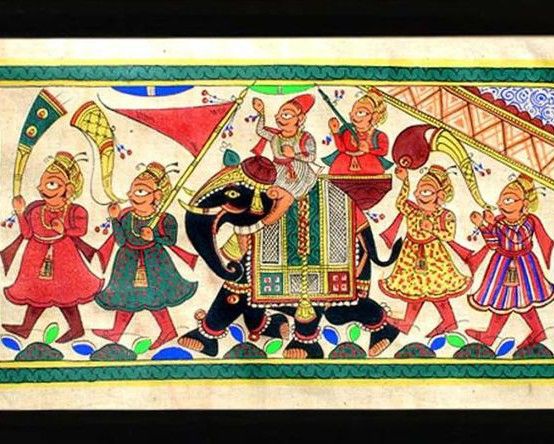Phad Art: A Colorful Storytelling Tradition

Have you ever seen a painting that tells a story? That’s exactly what Phad Art does! It is a beautiful and colorful painting style from Rajasthan, India, that has been used for hundreds of years to tell exciting stories of gods, heroes, and brave warriors.
Let’s explore the world of Phad art and learn why it is so special!
What is Phad Art?
Phad art is a folk painting that is usually done on long pieces of cloth or scrolls. These paintings tell stories, just like a comic strip! The word “Phad” means "fold" in the local language because these paintings were often rolled or folded when carried from one village to another.
Phad paintings are not just ordinary artworks; they are a way of storytelling. The stories are mostly about Pabuji and Devnarayan, two great Rajasthani heroes who are considered gods by some people. These paintings are used during religious ceremonies and village performances.
How is Phad Art Made?
Creating a Phad painting takes a lot of skill and patience. Here’s how artists make these colorful artworks:
1. Preparing the Cloth
Before painting, the artist takes a long piece of cloth and soaks it in a special solution of wheat starch and glue to make it strong. Then, the cloth is dried and polished using a stone to make it smooth.
2. Drawing the Outline
The artist first draws the entire story using a fine brush and black ink. This step is like making a sketch before coloring.
3. Adding Colors
Once the outline is ready, the artist fills in the painting with bright, natural colors made from flowers, stones, and herbs. The colors are:
- Orange & Yellow – Used for clothing and backgrounds
- Red – Represents energy and bravery
- Green – Symbolizes nature
- Blue – Used for gods and goddesses
- Black & White – For details and highlights
4. Final Touches
After coloring, the artist adds small details to make the painting look lively. The faces, jewelry, and costumes are painted very carefully.
Special Features of Phad Art
Phad art is unique and different from other paintings. Here are some cool facts about it:
1. Storytelling through Art
Phad paintings are not just for decoration—they tell entire stories! People gather around while a storyteller (called Bhopas) sings and explains the story shown in the painting.
2. No Empty Space
Unlike modern paintings, Phad art fills the entire canvas with colors and figures. There are no blank spaces! Everything, from trees to animals, is painted in detail.
3. Side-Facing Characters
Most characters in Phad paintings are drawn in side profiles. That means you can only see one eye of each person!
4. Handmade Natural Colors
The colors used in Phad paintings are made from natural materials like leaves, flowers, and minerals. That makes them eco-friendly and long-lasting.
Who are the Famous Phad Artists?
Phad painting is a family tradition that has been passed down for generations. The Joshi family of Rajasthan has been making Phad art for over 700 years!
One of the most famous artists is Shree Lal Joshi, who helped spread Phad art across the world. His son, Kalyan Joshi, continues this tradition and even teaches young artists how to paint Phad.
Why is Phad Art Important?
Phad art is an important part of Indian culture and history. It keeps old stories alive and helps people remember their traditions. Today, many artists are using Phad art in modern ways, like making paintings, clothes, and home decorations.
Phad art is a beautiful mix of storytelling and painting. It brings history to life with its bright colors and detailed figures. Even though it is a very old art form, it is still loved today by many people around the world.
If you ever visit Rajasthan, try to see a Phad painting in real life—you will feel like you are stepping into a magical storybook!